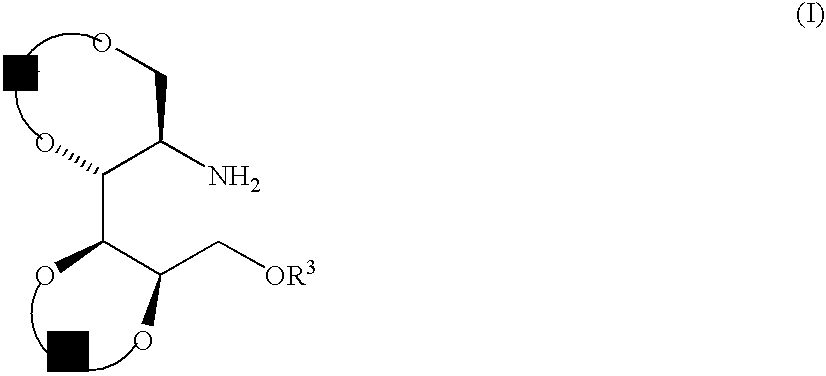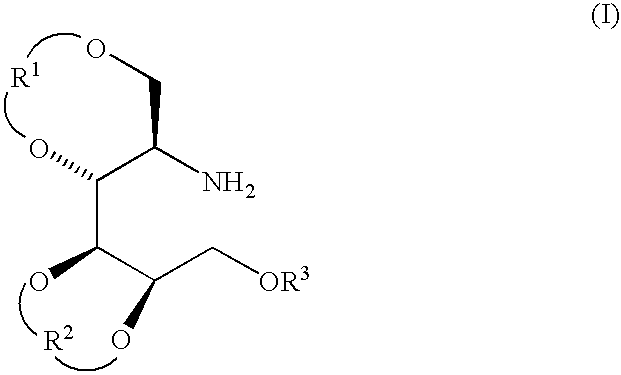Process for preparing kifunensine intermediate and kifunensine therefrom
a technology of kifunensine and intermediate, which is applied in the field of process for preparing kifunensine, can solve the problems of low overall yield and introduce many complications, and achieve the effect of simple chromatographic operation and reaction work-up, and greater processing eas
- Summary
- Abstract
- Description
- Claims
- Application Information
AI Technical Summary
Benefits of technology
Problems solved by technology
Method used
Image
Examples
example 1
Preparation of 6-O-tert-butyldiphenylsilyl-2-deoxy-2-acetylamino-D-mannose
[0076] 14
[0077] N-Acetyl-D-mannosamine (1) (50.7g, 0.21 mol) was dissolved in 500 mL of anhydrous N,N-dimethylformamide and the mixture was concentrated to dryness. This was repeated and the resulting residue was then redissolved in 400 mL of anhydrous N,N-dimethylformamide and placed under an inert atmosphere. Imidazole (21.3 g, 0.31 mol) was added as a single portion and the solution cooled to 0.degree. C. tert-Butyldiphenylsilyl chloride (67 g, 0.24 mol), in 100ml of anhydrous N,N-dimethylformamide, was added dropwise, at 0.degree. C., over 2.5 hour and the mixture left to stir for a further 30 min. A further portion of tert-butyldiphenylsilyl chloride (2.9 g, 0.01 mol) was added dropwise and the mixture left to stir for a further 30 min at 0.degree. C. The reaction was quenched by the addition of 100 mL of water. The mixture was partitioned between 1500 mL of water and 750 mL of ethyl acetate and the aqueo...
example 2
Preparation of 6-O-tert-butyldiphenylsilyl-2-deoxy-2-acetylamino-D-mannito-l
[0079] 15
[0080] The monosilylated material (2) (90 g, 0.20 mol) was dissolved in 1 L of distilled methanol and the solution cooled to 0.degree. C. under an inert atmosphere. Sodium borohydride (36 g, 0.98 mol) was added portionwise over 1.5 hour at 0-5.degree. C. The mixture was allowed to warm to room temperature with stirring over 16 hours. The majority of the methanol (approx. 700 mL) was removed under reduced pressure and the resulting grey suspension was diluted with water (250 mL). Hydrochloric acid (1 M; 190 mL) was added dropwise at room temperature to provide a white suspension. Ethyl acetate (500 mL) was added and the suspension stirred for 30 minutes to provide homogeneous aqueous and organic phases. The aqueous layer was separated and further extracted with 2.times.500 mL of ethyl acetate. The organic layers were combined and washed with saturated, aqueous sodium bicarbonate (300 mL) and saturate...
example 3
Preparation of 6-O-tert-butyldiphenylsilyl-2-deoxy-2-acetylamino-D-mannito-l
[0081] 16
[0082] The monosilylated material (2) (2 g, 4.4 mmol) was dissolved in 25 mL of distilled methanol and 25 mL of distilled water and the solution placed in the `bomb` hydrogenation apparatus. Raney Nickel (NDHT-MO, 0.25 g) was further added and the resulting suspension agitated at 85.degree. C., under hydrogen (50 bar), for 7 hours. The reaction mixture was cooled to room temperature, filtered through Celite and the filter cake washed with methanol (2.times.15 mL). The solvent was removed under reduced pressure to afford a colourless foam (2 g, quantitative). The data obtained corresponded to that observed for the synthesis of (3) depicted in Example 2.
PUM
| Property | Measurement | Unit |
|---|---|---|
| pH | aaaaa | aaaaa |
| temperature | aaaaa | aaaaa |
| pressure | aaaaa | aaaaa |
Abstract
Description
Claims
Application Information
 Login to View More
Login to View More - R&D
- Intellectual Property
- Life Sciences
- Materials
- Tech Scout
- Unparalleled Data Quality
- Higher Quality Content
- 60% Fewer Hallucinations
Browse by: Latest US Patents, China's latest patents, Technical Efficacy Thesaurus, Application Domain, Technology Topic, Popular Technical Reports.
© 2025 PatSnap. All rights reserved.Legal|Privacy policy|Modern Slavery Act Transparency Statement|Sitemap|About US| Contact US: help@patsnap.com



